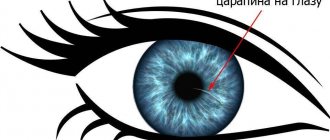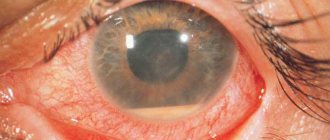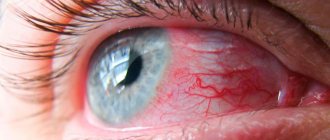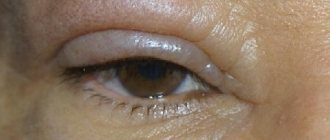Quite often, even minor eye damage leads to vision impairment. In exceptional cases, such damage can cause blindness. At the same time, a lot depends on the timely provision of emergency medical care. After all, without it, the likelihood of serious complications (intraocular hemorrhages, loss of internal membranes, intraocular purulent infection) increases significantly and threatens the loss of the organ of vision.
Next, let's look at the most important points in providing medical care in case of a blow to the eye, and figure out what to do if it hurts, is red and swollen.
Contusion (bruise) of the eye
Most often, a contusion (or bruise) of the eye occurs due to a blow to the eyeball with some object. For example, with a fist during a fight or with a snowball during a game. The affected person feels a sharp pain in the eye, lacrimation appears, photophobia occurs, and visual acuity may sharply decrease.
If there is no rupture of the eyeball or a penetrating wound, then at the first moment the victim may not feel any consequences. But after some time, vision suddenly becomes worse. It is worth remembering that even seemingly minor eye injuries can lead to very serious complications. Therefore, you should not self-medicate under any circumstances. It is better to immediately seek medical help from an ophthalmologist. Only he, after the examination, will be able to prescribe the necessary treatment for you and monitor the condition of your eye.
What urgent measures need to be taken before visiting a doctor? To begin with, you need to provide the injured eye with absolute rest. To do this, completely eliminate movements and turns of the head, stop any, even minimal, physical activity (bending forward, lifting heavy objects, sudden movements). Next, you need to apply a sterile gauze bandage to the eye, which can be soaked in antibiotic eye drops (Levomycetin or Albucid). This will serve as a good prevention of infections.
First aid for blunt eye injury
One of the most common causes of injury to the eyeball is injury from a blunt object. The presented phenomenon is also commonly called eye contusion.
The first thing to do when providing first aid for a contusion is to establish the type of injury. As a rule, there are 2 main types:
- primary – only the eye is damaged;
- indirect – both the eye and the adjacent areas (upper eyelid, nose, forehead) are damaged.
First aid for eye injury with a blunt object during primary contusion should begin with the need to ensure complete rest for the victim. You need to lay him on his back or sit him on a chair. In addition, it is extremely important to stabilize the emotional state of the victim. This need is due to the fact that during this type of lesion hemorrhage in the sclera is often visualized. With nervous tension, the volume of hemorrhages may increase. Sedatives will help prevent this.
Symptoms
The severity of the developing symptoms of an eye injury depends on the degree of mechanical impact on the area of damage and the time that has passed since the injury. With a mild injury, symptoms may not appear at all, and after a slight injury, the discomfort quickly passes. In this case, there is no penetrating wound to the eyeball, which means the bruise can be classified as superficial.
If the injury is more complex and the force is significant, the symptoms of an eye injury are pronounced and easily diagnosed. In addition, if the soft tissues of the orbit are severely damaged, a bruise can have adverse consequences that manifest themselves over time and can cause decreased vision or partial (complete) loss of vision.
Classification
The disease is classified according to the nature of the damage and the degree of its severity.
There are 4 degrees of severity of concussion:
- The first degree is characterized by minor hemorrhages in the orbital tissue, under the conjunctiva of the eyeball without ruptures or violation of the integrity of internal structures.
- In the second degree, swelling of the cornea is observed, tears of the iris from the pupillary edge, and minor damage to the surface layers of the sclera are possible.
- The third degree of severity implies severe damage to the eyeball and adjacent soft tissues and bone structures of the orbit. There are defects in the cornea, iris, sclera, massive hemorrhages in the chambers of the eye, under the conjunctiva, and retina. Fractures of the orbital walls are noted.
- The fourth degree includes extremely severe lesions. Multiple gross destruction of eye structures with loss of the iris, lens, bone fractures, internal and external bleeding, separation or compression of the optic nerve are characteristic of this stage.
Mechanism of injury
At the moment of contusion, the eyeball is displaced and the structures that make it up are compressed.
At the same time, intraocular pressure increases and the pupil sharply dilates. Fluid rushing into the anterior chamber can cause tears in the iris along the pupillary edge or in the corners of the chamber.
The lens shifts, the ligament supporting it may not withstand the load and may break. Subluxation or dislocation of the lens occurs, and it falls out into the vitreous or anterior chamber. Ruptures of the lens capsule cannot be ruled out.
From vessels damaged by trauma, blood flows under the mucous membrane, chorionic membrane, retina, or into the chambers of the eye. The degree of hemorrhage that occurs varies.
Due to the tension of the structures at the time of injury, separation, ruptures or detachment of the retina is possible.
With severe injuries, rupture of the fibrous capsule of the eyeball may occur. More often this happens at the border of the limbus or at the attachment points of the extraocular muscles.
Ruptures or compression of the optic nerve are possible when the bone structures of the orbit are damaged.
Consequences of eye injury
If you do not see a doctor after an eye injury, complications are possible that also affect the healthy organ. The most favorable prognosis is for corneal edema, which resolves within 7 days. More severe consequences are caused by inflammation of the cornea, called keratitis. A patient with this pathology experiences severe pain and photophobia; he cannot open the injured eye. If erosion or keratitis is not treated, an ulcer develops. This pathology is provoked by the growth of bacterial microflora. If left untreated, the patient experiences pinched iris and optic nerve atrophy.
Consequences of other eye injuries:
- Burns from chemicals, especially meadows, pose a great danger to the eye. They penetrate deep into the tissue, dissolving the protein and destroying the anatomical structures of the eye. The consequences of this process appear after 3 days. Patients are diagnosed with secondary glaucoma, cataract, and atrophy of the eyeball as a complication.
- If, when the organ of vision is injured, the outflow of intraocular fluid is disrupted, the patient's intraocular pressure increases, which leads to glaucoma. This pathology causes nerve death and blindness.
- When the inflammatory process spreads to the tissue of the eyeball, endophthalmitis is diagnosed. This complication leads to loss of vision and subsequently spreads to the meninges, causing meningitis.
- After moderate to severe eye injury, vision deterioration is observed. Complete blindness is also possible.
- If the patient ignores a foreign body in the eye for a long time, his field of vision narrows. After this, retinal detachment and eye atrophy are diagnosed.
An unfavorable prognosis for eye injury is possible in patients who do not consult a doctor in a timely manner. As a result of such actions, a healthy organ also suffers. Medical care allows you to avoid negative consequences for the anatomical structures of the eye and preserve vision.
Treatment of eye injury
If your eye is injured, you should contact a medical facility. In most cases, the victim is recommended to undergo outpatient treatment and is prescribed eye drops. The most popular are Albucid and Levomycetin. In case of hemorrhage, retinal detachment, penetrating injury and foreign body entry, the patient requires surgical intervention.
Eye bruises are usually treated on an outpatient basis. To restore blood vessels and improve microcirculation in the eye, the patient is prescribed hemostatic agents and angioprotectors. Physiotherapy is also practiced, in particular electrophoresis and UHF. In severe cases, the patient requires a corneal transplant.
For penetrating eye injuries, the patient is prescribed sulfonamides, antibiotics, anti-inflammatory and antifungal agents.
If foreign objects get into the cornea, the patient may not always be recommended to undergo surgery. You can do without surgery if plastic or glass gets into your eye. When an item quickly oxidizes, it must be removed immediately. If a foreign body gets into the conjunctival sac, it is removed with a special needle or tweezers, after injecting the patient with anesthesia.
If the injury is accompanied by loss of an eye, the victim is given an implant. A patient with an eye injury must be given a tetanus vaccine.
Treatment and prevention
Any, even minor, but long-term eye disease needs correction and proper treatment by a specialist. Doctors usually prescribe special medications for any disease. These are eye drops, as well as tablets, used primarily to get rid of other diseases in the body or intraocular infections.
Treatment and prevention of eye pain
Often patients are not prohibited from additionally using folk remedies. If eye pathologies appear or simply severe fatigue of muscles and nerves, it is recommended to carry out regular rinsing with solutions based on chamomile, plantain or seaweed.
To improve the health of the eyes or restore them after pathologies and injuries, clay treatment is used. This is a simple method consisting of applying clay applications. When the time comes to wash off these elements, use tea leaves.
The main method of preventing eye diseases is to follow the rules of hygiene, as well as the economical use of your own vision. You should give your eyes rest, perform special gymnastics if necessary, and also be careful when playing outdoor games or while working.
You should not allow your eyes to become overtired by constantly spending time reading a book with small, illegible text or at the computer. If the visual organs are strained as a result of a certain type of activity, it is necessary to organize periodic rest for the eyes.
Do eye exercises once an hour
It is advisable to combine eye gymnastics with special drops. In order to strengthen vision for a long time and improve the condition of the eye muscles, you should use mineral and vitamin complexes, and also do not forget about proper nutrition. This will help improve the body's defenses, resulting in a lower risk of contracting an infectious disease.










